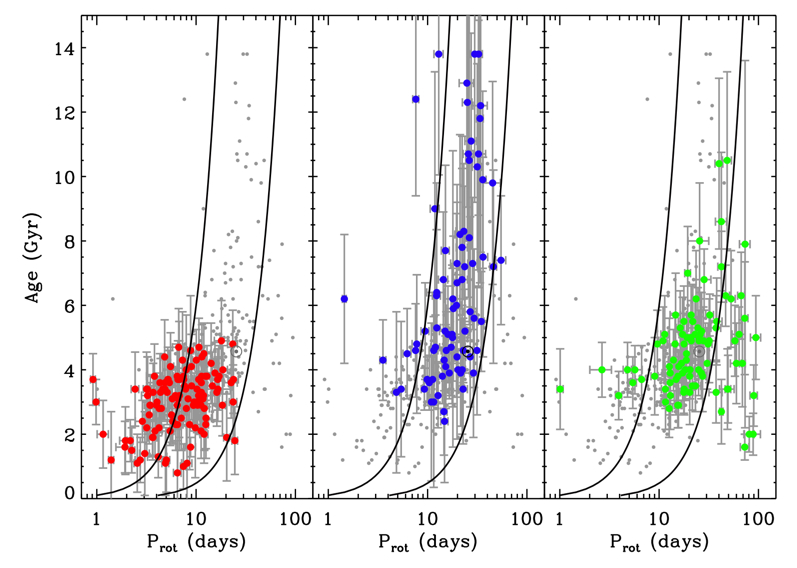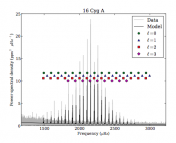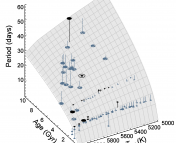- Title: Towards asteroseismically calibrated age-rotation-activity relations for Kepler solar-like stars
- Authors: R. A. García, T. Ceillier, D. Salabert, S. Mathur, J. L. van Saders, M. Pinsonneault, J. Ballot, P. G. Beck, Sl. Bloemen, T. L. Campante, G. R. Davies, J.-D. do Nascimento Jr., S. Mathis, T. S. Metcalfe, M. B. Nielsen, J. C. Suárez, W. J. Chaplin, A. Jiménez, and C. Karoff
- First Author’s Institution: Laboratoire AIM, CEA/DSM – CNRS – Univ. Paris Diderot – IRFU/SAp, Centre de Saclay, 91191 Gif-sur-Yvette Cedex, France
- Paper Status: Submitted to A&A
Twinkle, twinkle, little star,
Your brightness fluctuations reveal what you are.
(with apologies to Jane Taylor)
We have repeatedly seen how Kepler goes above and beyond its original mission of finding exoplanets. Today’s paper is no exception. For 540 stars observed by Kepler, García et al. measure rotation periods and photometric magnetic variability for 310 of them. They use previous results from asteroseismology to investigate relationships between the stars’ ages, rotation rates, and levels of magnetic activity.
What’s in a light curve?
Many different physical effects can be responsible for a star’s changing brightness with time. These include:
- Eclipses. If the star is in a binary system, or hosts a planetary system, these companions can pass in front of each other and change the amount of light we see. García et al. use this to find and exclude a handful of known eclipsing binaries and planet host stars from their sample.
- Pulsations. Many stars, including our Sun, have sound wave oscillations that propagate in their convection layers. These solar-like oscillations are measured using asteroseismology and can be used to estimate many properties, including stellar ages to within about 1 billion years (this is actually remarkably precise!). García et al. use a recent asteroseismic study of 540 stars in the Kepler field as a starting point.
- Rotation. Stars aren’t perfectly uniform spheres. As star spots and other surface features move in and out of view, they let us measure a rotation period. García et al. successfully do this for 310 of the 540 identified pulsating stars.
- Overall variability. In addition to measuring individual bumps in a star’s light curve, quantifying the overall level of variability is a way to measure a star’s magnetic activity. If it has a large standard deviation, we say the star has a high photometric variability, and therefore a significant amount of magnetic activity. García et al. also measure this quantity for their sample of 310 rotating, pulsating stars.
Putting the pieces together
Because stars at different stages of their lives are physically very different, the authors split their sample into three categories based on temperature and surface gravity: hot stars, cool main-sequence dwarfs, and subgiants. All these stars are referred to as “solar-type” simply because they show global physical characteristics similar to the Sun that we can observe with asteroseismology, not because they share all of our Sun’s properties.

Rotation rates (left) and levels of magnetic activity (right) for the sample of 310 oscillating stars. The stars are divided into three groups: hot stars (red), cool main-sequence stars (blue), and subgiants (green). As expected, hot stars spin faster than main-sequence stars, and subgiants spin more slowly. However, all three groups have about the same level of photometric magnetic activity.
As shown in the left histogram, the authors find that hotter stars spin faster than cool, main-sequence dwarfs. This result is expected, because cool main-sequence stars experience magnetic braking and generally “spin down” over time. Essentially, angular momentum is lost when material is caught in the star’s magnetic field and expelled. In contrast, hot stars should not show this trend, because they have a thinner layer of convection and magnetic braking is weaker. As stars expand and evolve into subgiants, conservation of angular momentum requires them to spin more slowly than before, and this is also observed.
Interestingly, the right histogram shows that all three categories of stars have similar levels of magnetic activity. The authors point out that these stars were pre-selected based on the criteria that they can be studied with asteroseismology, which may introduce two biases. First, magnetic activity has been shown to inhibit oscillations in some cases, which would skew the sample toward less overall magnetic activity. Second, stronger oscillations tend to appear in stars that are older, which would skew the sample toward an older population.

Ages from asteroseismology plotted against rotation rates for the sample of 310 oscillating stars. Solid black curves represent a previously-derived period-age relationship for cool main-sequence stars. As expected, the cool main-sequence stars (blue) in the authors’ sample fall between these lines. However, hot stars (red) and subgiants (green) have their own trends, and it would be incorrect to adopt the same period-age relation for all stars.
Finally, the authors look at how rotation and magnetic activity vary with age. As shown above, they find a clear relationship between age and rotation, but that relationship is different for different kinds of stars. The connection between age and magnetic activity is less clear.
One result stands out: if you want to use easily-measured quantities like stellar rotation or amount of magnetic activity to learn about a star’s age, it is crucial to know what kind of star you are looking at.





Thank you for that really helpful summary, Meredith.
It interests me to read that stars produce acoustic signals as I’ve only recently discovered to my astonishment that (sort of?) sound propagated in the early universe.
I’ve got to do a search through astrobites to see if there is an explanation here of baryonic acoustic oscillation. If there isn’t – could you ( singular or plural!) put this recent arXiv paper on your suggestion list??
http://arxiv.org/abs/1404.1801
Baryon Acoustic Oscillations in the Lyα forest of BOSS DR11 quasars
Timothée Delubac, Julian E. Bautista, Nicolás G. Busca, et al
Best wishes and again thanks to you all for providing this great website.
Margarita
Hi Margarita,
This astrobite might help answer some of your questions: http://astrobites.org/2013/08/27/a-classic-paper-how-did-the-largest-scale-structure-in-the-universe-form/
Sound waves are really just pressure waves, so any time you have enough “stuff” to compress and change the density and pressure, you naturally get oscillations. I agree it is pretty neat, and very handy in a wide range of situations.
Thanks a lot, Meredith. Most helpful.
I think I’ve had it so pummelled into me that “in the absence of air there is no sound”, that obvious points like the fact that something akin to sound travels through water (think whales) had escaped my attention! So, where there is stuff that can be compressed, whether it’s in stars, in the pre-ionised universe (?) or in water, oscillations can take place. Very satisfying to grasp.
I’ve had a PDF made of Zachary’s very detailed astrobite so that I can re-read it offline.